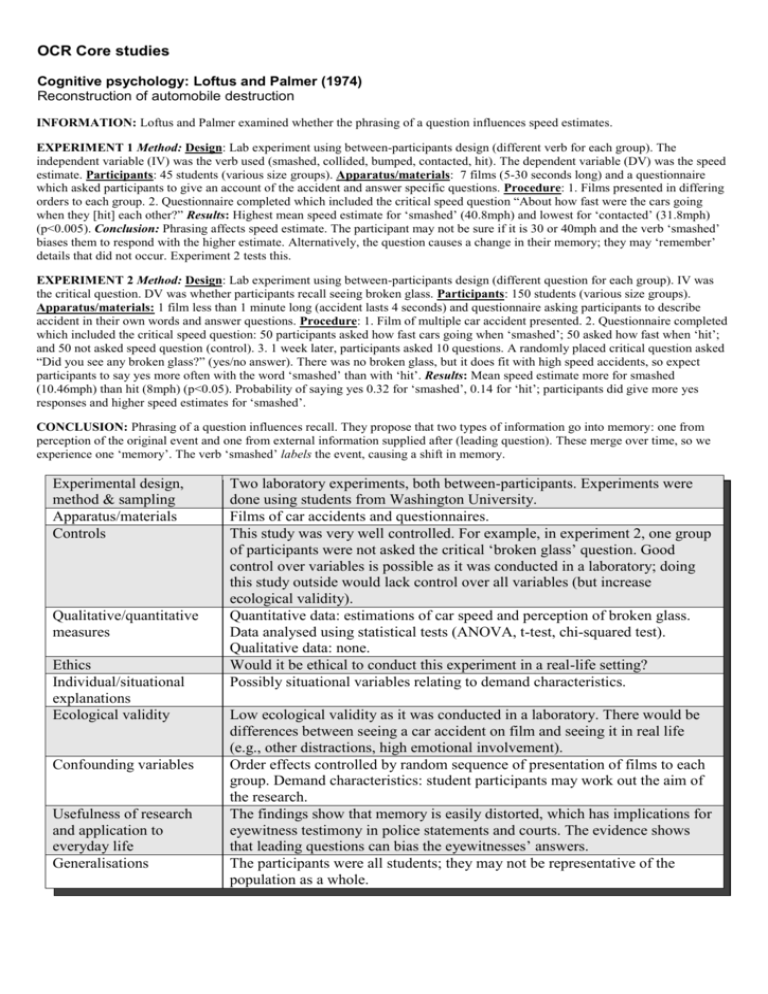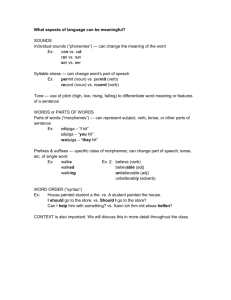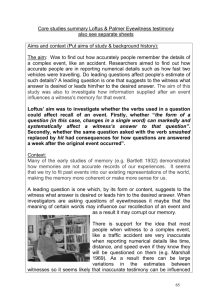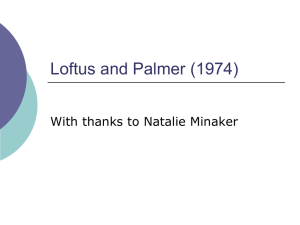OCR Core studies
advertisement

OCR Core studies Cognitive psychology: Loftus and Palmer (1974) Reconstruction of automobile destruction INFORMATION: Loftus and Palmer examined whether the phrasing of a question influences speed estimates. EXPERIMENT 1 Method: Design: Lab experiment using between-participants design (different verb for each group). The independent variable (IV) was the verb used (smashed, collided, bumped, contacted, hit). The dependent variable (DV) was the speed estimate. Participants: 45 students (various size groups). Apparatus/materials: 7 films (5-30 seconds long) and a questionnaire which asked participants to give an account of the accident and answer specific questions. Procedure: 1. Films presented in differing orders to each group. 2. Questionnaire completed which included the critical speed question “About how fast were the cars going when they [hit] each other?” Results: Highest mean speed estimate for ‘smashed’ (40.8mph) and lowest for ‘contacted’ (31.8mph) (p<0.005). Conclusion: Phrasing affects speed estimate. The participant may not be sure if it is 30 or 40mph and the verb ‘smashed’ biases them to respond with the higher estimate. Alternatively, the question causes a change in their memory; they may ‘remember’ details that did not occur. Experiment 2 tests this. EXPERIMENT 2 Method: Design: Lab experiment using between-participants design (different question for each group). IV was the critical question. DV was whether participants recall seeing broken glass. Participants: 150 students (various size groups). Apparatus/materials: 1 film less than 1 minute long (accident lasts 4 seconds) and questionnaire asking participants to describe accident in their own words and answer questions. Procedure: 1. Film of multiple car accident presented. 2. Questionnaire completed which included the critical speed question: 50 participants asked how fast cars going when ‘smashed’; 50 asked how fast when ‘hit’; and 50 not asked speed question (control). 3. 1 week later, participants asked 10 questions. A randomly placed critical question asked “Did you see any broken glass?” (yes/no answer). There was no broken glass, but it does fit with high speed accidents, so expect participants to say yes more often with the word ‘smashed’ than with ‘hit’. Results: Mean speed estimate more for smashed (10.46mph) than hit (8mph) (p<0.05). Probability of saying yes 0.32 for ‘smashed’, 0.14 for ‘hit’; participants did give more yes responses and higher speed estimates for ‘smashed’. CONCLUSION: Phrasing of a question influences recall. They propose that two types of information go into memory: one from perception of the original event and one from external information supplied after (leading question). These merge over time, so we experience one ‘memory’. The verb ‘smashed’ labels the event, causing a shift in memory. Experimental design, method & sampling Apparatus/materials Controls Qualitative/quantitative measures Ethics Individual/situational explanations Ecological validity Confounding variables Usefulness of research and application to everyday life Generalisations Two laboratory experiments, both between-participants. Experiments were done using students from Washington University. Films of car accidents and questionnaires. This study was very well controlled. For example, in experiment 2, one group of participants were not asked the critical ‘broken glass’ question. Good control over variables is possible as it was conducted in a laboratory; doing this study outside would lack control over all variables (but increase ecological validity). Quantitative data: estimations of car speed and perception of broken glass. Data analysed using statistical tests (ANOVA, t-test, chi-squared test). Qualitative data: none. Would it be ethical to conduct this experiment in a real-life setting? Possibly situational variables relating to demand characteristics. Low ecological validity as it was conducted in a laboratory. There would be differences between seeing a car accident on film and seeing it in real life (e.g., other distractions, high emotional involvement). Order effects controlled by random sequence of presentation of films to each group. Demand characteristics: student participants may work out the aim of the research. The findings show that memory is easily distorted, which has implications for eyewitness testimony in police statements and courts. The evidence shows that leading questions can bias the eyewitnesses’ answers. The participants were all students; they may not be representative of the population as a whole.








